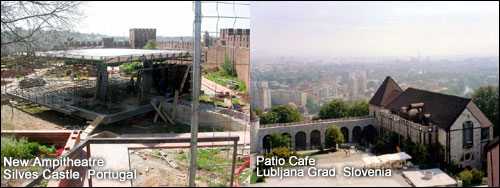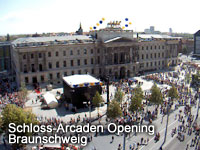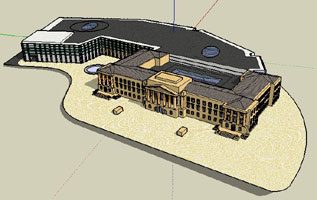(if this image is just a pretty palace, click refresh to reload the animated gif and enjoy a quick look at the rebuilding of the schloss)

I am always both fascinated and charmed to see an older building lovingly restored and doubly so when its role is thoughtfully reconsidered and creatively re-purposed. The magnificent ducal place in Braunschweig has been carefully reconstructed and redeveloped as part of a shopping arcade in the city centre. The palace itself was torn down in 1960 following years of gradual disintegration and bomb damage during the WWII that left much of the city centre devastated. Although remnants of the old palace were used in the reconstruction begun in 2005, the bulk of the construction material is new. Despite this, the effect overall effect of the reconstruction is gorgeous, and tribute to the craftsmanship of those involved. There have been a number of critics that feel that such a building should only be used as museum or a public non-commercial space. I heartily disagree.
 I have been fortunate enough to have stumbled across other fine examples of such re-purposing in my own travels. I was very struck by the grad in Lubljana, Slovenia, which features a theatre, a gallery, a number of wonderful cafes and a magnificent green space in the confines of the restored castle. More recently, visiting a splendid example of Moorish castle design in Silves, Portugal, I was disappointed to discover upon paying my entry fee that most of the castle was off limits as it was under reconstruction. The project here was similar. There is a huge open air theatre being reconstructed in the castle courtyard.
I have been fortunate enough to have stumbled across other fine examples of such re-purposing in my own travels. I was very struck by the grad in Lubljana, Slovenia, which features a theatre, a gallery, a number of wonderful cafes and a magnificent green space in the confines of the restored castle. More recently, visiting a splendid example of Moorish castle design in Silves, Portugal, I was disappointed to discover upon paying my entry fee that most of the castle was off limits as it was under reconstruction. The project here was similar. There is a huge open air theatre being reconstructed in the castle courtyard.
Projects such as this are bringing historical artifacts back to life and back into the local community. There are valid concerns that reconstruction can blatantly misrepresent the past, or that a priceless connection with the past is being lost through re-purposing. However, such projects call for sensitivity to the social role of the historical object. Feudalism aside (yeah, that’s a biggy, but bear with me) the castle was the centre of community. Bringing these spaces back into public use, even sometimes with an odious smell of commercialism, doesn’t necessarily abrogate their historical role.  I am reminded immediatelly of Palais Royal in Paris, remembered as the residence of the Duc d’Orleans prior to the French Revolution. Commercial space was a permanent part of the palace, helping defray the cost of upkeep, and politically significant as one means by which the Duc maintained a connection to the common folk. The Palais featured public space that was utilized by the community.
I am reminded immediatelly of Palais Royal in Paris, remembered as the residence of the Duc d’Orleans prior to the French Revolution. Commercial space was a permanent part of the palace, helping defray the cost of upkeep, and politically significant as one means by which the Duc maintained a connection to the common folk. The Palais featured public space that was utilized by the community.
The development of the Schloss-Arcaden in Braunschweig is $US270M project. Realistically as much as we claim to treasure our past, there’s no other way that such sums can be raised to accomplish these projects with such sensitivity. Being a frequent user of cafe spaces here in Canada, I can only marvel at the experience to be had in the wonderful balcony space in this new old castle – a Starbucks I understand, according to a German contact. OK, that fact raises some issues, but I won’t go there right now.
By the way, I used a series of webcam shots of the construction project to put together an animated view of the rebuilding process – warning…it is a tad large at 3.2Mb. I hope that little animation works for you and would love hear any feedback.
Update: The animated GIF got picked up by a couple German sites, which was quite cool. This got me thinking about different ways that the Schloss-Arcaden might be represented.
- A 3D SketchUp! Model of the Schloss
- A couple photoblog shots suggesting some intriguing spaces inside the schloss-arcaden
- Some great night shots
- A great video from the unveiling
- Some aerial construction shots to appreciate the scale of the project
Its interesting to see the range of media immediately available and shared about a project such as this. The world grows smaller still.
3D model of the Schloss-Arcaden uploaded by EMOTION to the Google 3D Warehouse.

